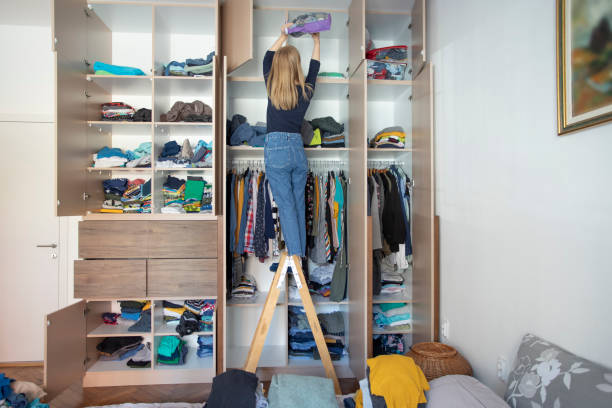Is your closet a chaotic mess? Do you often find yourself frustrated searching for clothes, shoes, or accessories buried in a mountain of clutter? You’re not alone. Closets tend to become catch-all spaces for things we no longer use, wear, or even remember owning. The good news? With a systematic approach, you can transform your cluttered closet into a clean, functional, and inspiring space. This comprehensive guide will walk you through everything you need to know about cleaning and organizing your closet from top to bottom.
1. Why Closet Organization Matters
A well-organized closet isn’t just about aesthetics; it’s about improving your day-to-day life. Here’s why it matters:
- Saves Time: No more frantic mornings hunting for the right outfit.
- Saves Money: You stop buying duplicates or clothes you already own.
- Boosts Mental Clarity: A clean space leads to a clear mind.
- Improves Fashion Choices: When you can see what you have, you wear more of what you love.
Think of your closet as your personal dressing room. If it’s functional and beautiful, it uplifts your entire mood.
2. Step-by-Step Closet Cleaning Process
Before you can organize, you must clean. Here’s how to do it effectively:
Step 1: Empty Everything
Take everything out of the closet. This allows you to assess what you have and clean thoroughly.
Step 2: Clean the Space
- Dust shelves and rods.
- Vacuum or mop the floor.
- Wipe down walls and any bins or storage boxes.
Step 3: Air It Out
Leave the closet empty for a few hours with the doors open. This reduces odors and gives the space a fresh feel.
3. Decluttering: What to Keep, Toss, or Donate
Decluttering is the heart of closet organization. Be ruthless but mindful.
Questions to Ask Yourself:
- Have I worn this in the last year?
- Does it fit me now?
- Is it damaged or worn out?
- Does it align with my current style?
- Would I buy this again?
The Four-Pile Method:
- Keep: Only items that serve you now.
- Donate: Good condition, but no longer needed.
- Sell: Designer or barely worn items.
- Toss: Damaged beyond repair.
Tip: Use the Marie Kondo principle: Does it spark joy?

4. Organizing Strategies for Every Closet Size
Closets come in all shapes and sizes. Tailor your organization strategy to fit your space.
Small Closets
- Use slim, space-saving hangers.
- Maximize vertical space with over-the-door organizers.
- Store out-of-season clothes elsewhere.
Walk-In Closets
- Designate zones (tops, bottoms, shoes, accessories).
- Add drawer units or shelves for folded items.
- Use baskets for smaller items.
Reach-In Closets
- Install a double rod system.
- Use hanging shelves for shoes or sweaters.
- Add hooks on the inner walls.
5. Storage Solutions and Closet Accessories
Closet tools can make or break your organization efforts.
Essential Storage Items:
- Shelf dividers: Keep stacks neat.
- Clear bins: Easy visibility of contents.
- Over-the-door organizers: Great for shoes, scarves, and jewelry.
- Drawer inserts: Tame socks, underwear, and accessories.
- Hanging organizers: Ideal for bags or bulky items.
Invest in:
- Velvet or wood hangers (uniform look + clothes stay put).
- Label makers or chalk labels for bins.
- Shoe racks or cubbies for footwear.
6. Seasonal Closet Rotation
If your closet can’t hold all seasons’ clothes at once, rotate seasonally.
How to Rotate:
- Sort by season: Winter vs. summer wardrobes.
- Pack smart: Use vacuum-sealed bags or lidded bins.
- Label: Always label containers for quick identification.
- Store elsewhere: Under-bed storage, attic, or spare closets.
Rotating your wardrobe keeps your closet current and clutter-free.
7. Closet Maintenance Tips
After you’ve done the hard work, keep it tidy with these habits:
- One-in, one-out rule: When you buy something new, donate or toss something old.
- Monthly mini check-ins: Tidy up hangers, refold items, and remove clutter.
- Laundry discipline: Don’t dump clean clothes in the closet—fold or hang them immediately.
- Seasonal reviews: Evaluate your wardrobe at the start of each season.
Consistency is the secret to long-term organization.
8. Closet Organization for Different Lifestyles
For Busy Professionals
- Use a weekly outfit planner.
- Hang workwear together, sorted by category.
- Use bins for gym or casual clothes.
For Fashion Enthusiasts
- Display your favorite pieces like a boutique.
- Color-code clothes for visual appeal.
- Use lighting inside the closet to spotlight items.
For Parents or Shared Closets
- Divide closet space clearly.
- Use labels or colored bins for each person.
- Lower shelves for kids’ easy access.
For Minimalists
- Adopt a capsule wardrobe.
- Keep only versatile, high-quality items.
- Avoid over-filling the closet, even if space allows.
9. Common Mistakes to Avoid
Avoiding these errors will ensure lasting success:
- Keeping clothes “just in case”
- Ignoring vertical space
- Using mismatched hangers
- Overstuffing the closet
- Failing to declutter before organizing
- Neglecting lighting or accessibility
- Skipping labels or forgetting systems
The goal is a system that’s sustainable and easy to maintain, not perfect-looking but impractical.
10. Final Thoughts: Transform Your Closet, Transform Your Life
Cleaning and organizing your closet may seem like a small act, but it holds surprising power. A clutter-free wardrobe saves time, reduces stress, and helps you feel more in control. You rediscover pieces you love, let go of what no longer serves you, and step into each day with confidence and clarity.
Whether you’re decluttering a tiny corner wardrobe or redesigning a spacious walk-in, the key is to be intentional. Let each item in your closet reflect your style, purpose, and the life you want to lead.
Quick Closet Checklist
- Empty the entire closet
- Deep clean all surfaces
- Sort items into keep/donate/sell/toss
- Group similar items together
- Add bins, baskets, and hangers
- Label everything clearly
- Rotate seasonal items
- Maintain weekly and monthly
